Last updated: July 28, 2023
Article
Glen Echo Park: Center for Education and Recreation (Teaching with Historic Places)
The foot-hills of the Blue Ridge Mountains hurry down to the Potomac at Glen Echo and there pause in high plateau overlooking the long descent of the majestic river. Bold and precipitous they drop 125 feet to the murmuring edge of the waters under the eloquent shade of the giant trees and luxuriant foliage. Looking to the East, when the sun is in midheavens, the white shaft of the Washington Monument gleams against a southern sky, blue and soft as Italy's. To the north uprise the caressing hills, so near their summits overhang the slumberous highland plain; to the south the river, and above its shining waters the Virginia hills in long line and competing altitudes; to the west a picturesque stretch of plain, and then the misty line of the Blue Ridge, confusing itself with the configuration of the clouds.1
This spectacular Maryland location, so lovingly described by Edward and Edwin Baltzley, its first developers, has served the people of Washington, D.C., as a center for education and recreation for more than 100 years. It was first developed as a chapter of the widespread Chautauqua movement–a Protestant ecumenical effort to democratize learning and spread culture from the well-to-do to the masses. Early in the 20th century the area was redeveloped as a trolley park, and now the site is preserved as a national park. The trends that impacted the development and redevelopment of the Glen Echo Park site are not unusual; the fact that they impacted the same area of space is. This unique survivor, a traditional gathering place for the people of Washington, D.C., provides students with the opportunity to study the evolution of the American concepts of education, recreation, and social interaction in the late 19th and 20th centuries.
1. Edwin Baltzley, Glen Echo on the Potomac: Washington Rhine (Philadelphia: Frank Gutekunst Press), 1891.
About This Lesson
This lesson is based on the National Register of Historic Places registration file "Glen Echo Amusement Park" (with photographs) park planning documents, and newspaper and magazine accounts. It was written by Stephanie Gray, former Park Ranger at neighboring Clara Barton National Historic Site. TwHP is sponsored, in part, by the Cultural Resources Training Initiative and Parks as Classrooms programs of the National Park Service. This lesson is one in a series that brings the important stories of historic places into the classrooms across the country.
Where it fits into the curriculum
Topics: This lesson could be used in American history units on the Gilded Age and the Progressive Era to explore religious and educational reform movements, and the impact of improved transportation systems on settlement patterns. The lesson also explores the issue of public segregation.
Time period: Late 19th century to modern day
United States History Standards for Grades 5-12
Glen Echo Park: Center for Education and Recreation relates to the following National Standards for History:
Era 6: The Development of the Industrial United States (1870 to 1900)
-
Standard 1B- The student understands the rapid growth of cities and how urban life changed.
-
Standard 1D- The student understands the effects of rapid industrialization on the environment and the emergence of the first conservation movement.
-
Standard 2C- The student understands how new cultural movements at different social levels affected American life.Era 7: The Emergence of Modern America (1890 to 1930)
-
Standard 3B- The student understands how a modern capitalist economy emerged in the 1920s.
-
Standard 3C- The student understands how new cultural movements reflected and changed American society.Era 9: Postwar United States (1945 to early 1970s)
-
Standard 4A- The student understands the "Second Reconstruction" and its advancement of civil rights.
Curriculum Standards for Social Studies
(National Council for the Social Studies)
Glen Echo Park: Center for Education and Recreation relates to the following Social Studies Standards:
Theme I: Culture
-
Standard B - The student explains how information and experiences may be interpreted by people from diverse cultural perspectives and frames of reference.
-
Standard C - The student explains and gives examples of how language, literature, the arts, architecture, other artifacts, traditions, beliefs, values, and behaviors contribute to the development and transmission of culture.
Theme III: People, Places, and Environment
-
Standard A - The student elaborates mental maps of locales, regions, and the world that demonstrate understanding of relative location, direction, size, and shape.
-
Standard G - The student describes how people create places that reflect cultural values and ideals as they build neighborhoods, parks, shopping centers, and the like.
Theme IV: Individual Development and Identity
-
Standard E - The student identifies and describes ways regional, ethnic, and national cultures influence individuals' daily lives..
-
Standard G - The student identifies and interprets examples of stereotyping, conformity, and altruism.
Theme VIII: Science, Technology, and Society
-
Standard A - examine and describe the influence of culture on scientific and technological choices and advancement, such as in transportation, medicine, and warfare.
-
Standard B - show through specific examples how science and technology have changed people's perceptions of the social and natural world, such as in their relationships to the land, animal life, family life, and economic needs, wants and security.
Objectives for students
1) To describe the national social trends and technological improvements that influenced the settlement and continued use of the Glen Echo area.
2) To explain the social and economic needs Glen Echo Park was designed to serve.
3) To identify present or past gathering places in their own community, and to identify factors that have contributed to the continued use or the destruction of those places.
4) To determine the effect of segregation and discrimination on their own community.
Materials for students
The materials listed below either can be used directly on the computer or can be printed out, photocopied, and distributed to students. The maps and images appear twice: in a low-resolution version with associated questions and alone in a larger, high-resolution version.
1) one map of Glen Echo, Maryland and the surrounding region;
2) two readings on the Chautauqua movement and trolley/amusement parks;
3) onw drawing of Glen Echo Park today;
4) five historical and modern photos of Glen Echo Park.
Visiting the site
Glen Echo Park, located at 7300 MacArthur Boulevard in Glen Echo, Maryland, is maintained by the National Park Service as an educational and cultural forum where artists, students, teachers, and visitors can meet and exchange ideas. Professionals in fields ranging from performing and visual arts to consumer-oriented topics are invited to move into the remaining amusement park buildings and to bring them back to life. In exchange, the groups agree to open those facilities for public classes and to provide demonstrations and performances. For further information write to the Superintendent, George Washington Memorial Parkway, in care of Turkey Run Park, McLean, VA 22101 or visit the park web pages.
Getting Started
Inquiry Question

What does this appear to be?
What purpose might the facility serve?
What kind of organizations might build such a place?
Setting the Stage
The Chautauqua movement was just one of the great reform trends sweeping the nation at the end of the 19th century. Based on the idea that everyone desires self-improvement, the Chautauqua was a Protestant effort to provide affordable education, culture, and recreation for the growing middle class. The Chautauqua took the form of a residential community where families went to immerse themselves in theater, lectures, concerts, and other intellectual activities.
In 1888 brothers Edward and Edwin Baltzley sold their patent on the "spatterless egg beater" and their Keystone Manufacturing Company and purchased property a few miles outside the Washington, D.C., city limits. There they established a residential development called "Glen Echo on the Potomac." In 1891 the Baltzleys, who were experiencing difficulty selling property so far out in the country, deeded 80 acres of their Glen Echo property to create a National Chautauqua. They believed the Chautauqua would help make their property more attractive to potential buyers. The Baltzleys' idea to take advantage of this national trend paid off handsomely as thousands of people came to Glen Echo to attend the Chautauqua. After only one season, however, a widespread rumor of a malaria epidemic (a disease spread by certain mosquitoes) in Glen Echo forced the Chautauqua to close.
A short time later, the Columbian Exposition in Chicago in 1893 helped spark interest in mechanical rides and other organized entertainments of amusement parks. Trolley companies across the country began purchasing land and building small amusement parks at the city boundaries as a way to encourage riders. The riders of the trolley cars were admitted free to the park. In 1911 the Washington Railway and Electric Company bought Glen Echo and created a new, modern and very popular mechanical amusement park. By the 1960s, however, Americans found other forms of entertainment more compelling and attendance levels at small local amusement parks dropped dramatically. At Glen Echo, not only did other forms of entertainment compete with the park, but many local citizens did not agree with the park's segregation policy. Local citizens, both black and white, fought that practice by boycotting and picketing the park. These new challenges to the park's operation resulted in the closing of Glen Echo Amusement Park in 1968. Three years later, intense pressure by local citizens to protect the park site from adverse development led to the federal government obtaining the property in a land exchange and creating a national park dedicated to providing educational and recreational opportunities to all people.
Locating the Site
Map 1: Glen Echo, Maryland and surrounding region.
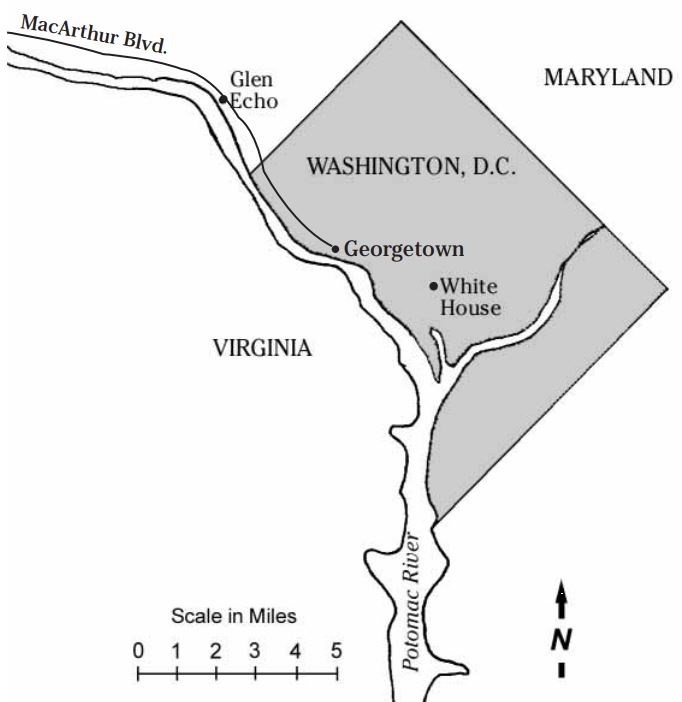
Glen Echo is a suburb of Washington, D.C. A suburb is a smaller community on the outskirts of a large city or town. Travel between the two communities has changed over the years, as technological improvements have greatly reduced the time required to complete the trip. Between 1888 and 1891, the only way available to journey to Glen Echo was by horse and wagon. Beginning in 1892, many people began to travel to Glen Echo via the trolley. The trolleys came directly out MacArthur Boulevard and averaged about 10 miles per hour. It was not until 1935 that people had the option to go to Glen Echo by car. On MacArthur Boulevard, there is currently a 35 mile per hour speed limit between Washington, D.C. and Glen Echo.
Questions for Map 1
1. Calculate the distances between Glen Echo and the city limits of Washington, D.C. On Conduit Road, now MacArthur Boulevard, there was a one-and-one-half mile per hour speed limit due to the rough corduroy road (made from trees that have been cut in half and laid crosswise on the road bed). How long do you think it would have taken to get to Glen Echo by horse and wagon?
2. How do technical improvements in transportation affect the way people think about distance?
3. What impact do you think technological improvements in transportation had on the development of suburbs and use and eventual disuse of local parks like Glen Echo?
Determining the Facts
Reading 1: The National Chautauqua of Glen Echo
The Chautauqua movement began in 1874 as a summer education program held at a camp on the banks of Chautauqua Lake in southwestern New York state. Lewis Miller, an Ohio businessman, had a great interest in improving educational opportunities for Americans. With John Vincent, a minister and national secretary of the Methodist Episcopal Church, he began his reform efforts by training Sunday school teachers in a camp-like setting. Their first program, the Chautauqua Assembly, lasted for two weeks and drew 500 select pupils who camped out in large tents. These Sunday school teachers attended daily classes, evening concerts and lectures, and spent their free time enjoying water sports and hikes in the clean country air.
That first summer program was so valued by the teachers that the sponsors quickly expanded their program. Over the next few years people from around the world and of all religions began to participate in the Chautauqua movement. Dedicated to providing the masses with an opportunity for recreation and education such as the middle classes enjoyed, the movement also became popular because it allowed city dwellers to spend some of the hot summer weeks away from the congested cities. It provided a blend of summer camp and university. The reputation of the New York Chautauqua was bolstered by visits from Lewis Miller's old friend, President Ulysses S. Grant, and his son-in-law, the great inventor Thomas Alva Edison.
By 1891 the movement was renamed the Chautauqua Institution. This more dignified name reflected the movement's enlarged pool of participants, its increased meeting time to two months, the housing of participants in their own small cottages or boarding houses during the "season," and the expansion of the Chautauqua idea to 53 more sites around the nation. Glen Echo was one of those sites.
Brothers Edwin and Edward Baltzley decided to support the Chautauqua program, and in March 1891 they deeded 80 acres of their development to a corporation known as National Chautauqua of Glen Echo which would "promote liberal and practical education, especially among the masses of people; their several pursuits and professions in life, and to fit them for the duties which devolve upon them as members of society."1 Among the 42 prominent people who served as members of the corporation was John Wesley Powell, famous one-armed explorer of the Colorado River and the American West.
Construction began quickly on two principal structures—the Amphitheater, which seated 8,000 people and was one of the largest auditoriums in the country, and the Hall of Philosophy. A stone tower, archway, and adjoining buildings were also under construction when the Chautauqua opened in June of 1891. The entire complex was planned in a rustic style. The courses offered by the New York Chautauqua Institution included Bible study, teacher training, lectures, and devotional exercises, as well as courses in geography, chemistry, physics, the use of microscopes, Shakespeare, elocution, stenography, calisthenics, languages, and the arts (especially music and entertainment). The Glen Echo version of the program was equally broad. Its courses included music (both vocal and instrumental), American history, languages (including Latin, French, German, and Hebrew), "The Care and Development of Physical Powers," "Methods for Secular Teachers," "Modern Poets," "English Authors," astronomy, geology and Egyptology.2 The Chautauqua also offered evening entertainment in the form of band concerts, poetry readings, and dances. Following is an example of the type of special programs offered at Glen Echo:
The Schedule of Events for July 4, 1892
The program will "occupy the time from 2:20 to 7:30; so that during the entire afternoon and evening there will be attractions in the great amphitheater as well as the sylvan pleasures which the place affords in such abundance. The eminent actor and elocutionist, Charles B. Hanford, will recite 'The Star Spangled Banner,' and Marie Antoinette Nathalie Pollard will recite the Declaration of Independence in costume. A grand musical program made up of performances by soloists who are favorites in Washington has also been prepared. It will include selections by Signor Vitale, violinist; Mark C. Baker, tenor; Eva Augusta Vescillius, soprano, and Louise V. Shelden, contralto. The grounds will be reached either by the excursion barge which runs hourly from Potomac Street canal or by electric railway. Coaches will run for the benefit of those who do not care to walk the short distance from the railway to the amphitheater."3
The Glen Echo Chautauqua's first season was a great success. Then, tragedy struck when a teacher at the park died of pneumonia. Rumors spread through Washington, D.C., that he had died of malaria, a disease carried by certain mosquitoes. People became reluctant to visit the area. The residential lots being sold by the Baltzleys lost much of their value which, in turn, cut the cash flow needed for the continued development of the National Chautauqua. The official Chautauqua program was closed in July 1892. The Baltzleys rented out the facilities to travelling show companies for five years and then leased part of the site to the newly-formed Glen Echo Company, which installed a small amusement park. In 1911 the brothers sold the land to the Washington Railway and Electric Company, which continued to develop an amusement park. The Washington Railway and Electric Company sold the park in 1955 to Baker Brothers, which continued to operate the park until it closed in 1968.
Although few other national Chautauqua sites were able to keep operating through the years, the New York Chautauqua remains popular today. Eighth and ninth generation families return to occupy family cottages each year. Some groups that folded, such as the one in Boulder, Colorado, have become revitalized in recent years. In many other places the only connection people had to a Chautauqua program was the opportunity to attend an evening of lectures or musical events sponsored by traveling Chautauqua troops. Altogether, the Chautauqua movement did attain the goals of Lewis Miller's dream. For a time, a great many Americans were able to improve their general knowledge and their understanding of the arts during their summer vacations.
Questions for Reading 1
1. What was the goal of the first Chautauqua?
2. Why do you think Chautauquas developed around the country? Why was a Chautauqua developed at Glen Echo?
3. Can you figure out what a "sylvan pleasure" might be? You may need to use a dictionary. Why would it be such a pleasure for people to leave the city for a few weeks and go to the Chautauqua?
4. What types of activities could people participate in at the Chautauquas? Would you have enjoyed these activities?
5. What methods of transportation could the people of Washington, D.C., have used to get to the Glen Echo Chautauqua celebration on July 4, 1892?
6. Why did the Baltzleys close the Glen Echo Chautauqua?
7. Try to discover three options people had for entertainment 100 years ago. Do we do those things today? What do you think has caused changes in the way people spend their leisure time?
Reading 1 was compiled from Gary Scott and Bill Brabham, "Glen Echo Amusement Park" (Montgomery County, Maryland) National Register of Historic Places Registration Form, Washington, D.C.: U.S. Department of the Interior, National Park Service, 1984; and Richard Campen, Chautauqua Impressions (Chagrin Falls, Ohio: West Summit Press, 1984).
1 Gary Scott and Bill Brabham, "Glen Echo Amusement Park" (Montgomery County, Maryland) National Register of Historic Places Registration Form, Washington, D.C.: U.S. Department of the Interior, National Park Service, 1984, Section 8, p. 1.
2Woman's Executive Committee, National Chautauqua, 2-3.
3Washington Evening Star, June 30, 1892.
Determining the Facts
Reading 2: The Glen Echo Amusement Park
The idea of public amusement parks, places where people could go for a short time to enjoy themselves and forget their daily problems, began in Europe in the early 19th century. In 1873 at the World's Fair in Vienna, Austria, people from around the globe experienced the thrill of riding a primitive ferris wheel, an updated version of the ancient carousel, and the "Russian Mountains," a two person car that rolled from a high platform down a track to its stopping point. These rides were so popular that improved versions as well as new kinds of thrilling rides quickly became important features of parks across the United States. For those who ran trolley systems, amusement parks located at the end of their tracks became a golden opportunity to make more money. The trolley companies not only had a way to get the people to the amusement parks, but access to the tremendous amounts of electricity needed to operate the rides. So rapidly did the idea grow that by 1902, Cosmopolitan magazine featured the following article by Day Allen Willey extolling the development of amusement parks operated by trolley systems:
The expression, "trolley-park" may not as yet have come into common use, but no explanation of its meaning is necessary. The oldest of the trolley-parks has been in existence but a few years, yet today these resorts are to be found in the outskirts of nearly every city in the land. The fact is that the street and suburban railway companies, realizing the profit arising by catering to the pleasure of the masses, have entered into the amusement field on an extensive scale.
Originally, few, perhaps none, of the promoters of the trolley-route thought of it as a means of carrying the pleasure-seeker to public parks. The main incentive was the business to be secured by transferring the throngs of toilers to and from store, office and factory, and forming a means of communication between the different parts of the city. With the advent of the electric car came the opportunity to build more homes amid more natural surroundings.
Townsfolk became more appreciative of the charms of the country, but trolley riding for enjoyment, which has become a summer habit in the larger centers of the population, was not thought of a decade ago. People of all classes availed themselves of the opportunity to get a breath of fresh air and pass the long evenings enjoying the "trolley-breeze," for a rapidly whizzing trolley-car [10 miles per hour] can stir a breeze in the stillest night of midsummer. The need of some place where one could alight and thus vary the monotony of the ride, led to the inception of the park scheme. These pleasure-grounds have been developed into resorts some of which are far more attractive than the public parks of the cities where they are located. Except for the nickel, dime or quarter which admits to the concert, rents the boat, or provides some other special amusement, the park is free to all, the company parks, combining natural and artificial diversions, have become the Mecca on holidays and Sundays not only of what we are pleased to term the working classes but of the "middle millions."1
Articles such as this one persuaded the Washington Railway and Electric Company of Washington, D.C., which was responsible for the installation of the electric railway system or "trolley system" throughout the city and its suburbs, to purchase the Chautauqua lands and expand the small amusement park that had already been built on the site. The company named their new purchase Glen Echo Amusement Park. They renovated the old Chautauqua buildings and added more buildings and more rides.
By 1931 a dance hall had been built and was charging five cents per dance. Soon a roller coaster, a new carousel, and bumper cars were added. The Crystal Pool was built to accommodate 3,000 swimmers. It was one of the largest in America with 1.5 million gallons of circulating water. Two years later the Spanish Ballroom was built adjacent to the pool. Throughout the 1940s additions to the park were constant. Two cafes and an arcade building added to the fun.
Glen Echo had become a favorite among the growing number of mechanical amusement parks built throughout the nation. Patrons with increasing amounts of leisure time could escape from their urban routines and enter a world of mechanically induced thrills and fantasies.
Although Willey's article in Cosmopolitan had stated that everyone was welcome at the trolley-parks, Glen Echo was a segregated park. Following is an excerpt from an article published in the Washington Afro-American in 1957:
Glen Echo Holds Steadfastly to Jim Crow
'Colored children are not welcome.' This statement was made Friday by G.P. Price, general manager of Glen Echo Park, who told the AFRO that colored children cannot participate in the Sustaining Fund Campaign for the National Symphony Orchestra on June 1. Mr. Price said "Colored children cannot participate because Glen Echo Park is patronized by whites only."2
In the summer of 1960, African and Anglo Americans picketed the park, standing outside the gates with signs. They organized petitions and antisegregation organizations filed lawsuits against the park's owners. Those who attempted to enter the gates of the park were arrested for trespassing. The efforts of those who thought all people should be able to enjoy Glen Echo park were successful. In 1961 the park opened on a nonsegregated basis. The victory won by the protestors came too late to allow all children very many good times at Glen Echo Park. By the mid-1960s, the park, like many other local amusement parks, was having trouble with newer, competing types of recreation, including the theme parks that were being built across the nation. Because of the automobile, people could easily travel farther and find interesting entertainment on a grander scale. Glen Echo Amusement Park shut its gates in 1968. In 1971, through a land exchange, the park was designated as a National Park Service site.
Before the National Park Service took over management of the site, many of the amusement park rides, including the roller coaster, were torn down or sold. The large Chautaugua amphitheater was deliberately burned down in 1956 to make room for a parking lot. Interested citizens raised the funds to purchase the carousel so it could be kept at the site. Today the National Park Service preserves the structures of Glen Echo's past, providing the setting for a center for culture and the arts—a use similar to its original mission as a Chautauqua.
Questions for Reading 2
1. Where did the concept of amusement parks first develop?
2. According to Day Allen Willey's article, why did the trolley companies build trolley parks? Why did they offer free admission to the parks?
3. Why would African Americans have been barred from Glen Echo Amusement Park?
4. What change in park admission policies came about in 1961? How do you think people felt about that change?
5. When did Glen Echo Amusement Park close? Why?
6. What newer types of recreation and amusement may have competed with the park?
Reading 2 was compiled from Gary Scott and Bill Brabham, "Glen Echo Amusement Park" (Montgomery County, Maryland) National Register of Historic Places Registration Form, Washington, D.C.: U.S. Department of the Interior, National Park Service, 1984; and Gary Kyriazi, The Great American Amusement Parks: A Pictorial History (Secaucus, N.J.: Citadel Press, 1976).
1Day Allen Willey, "The Trolley Park," Cosmopolitan 33 (July, 1902):265-267.
2"Glen Echo Park Holds Steadfastly to Jim Crow," Washington Afro-American, May 28, 1957.
Visual Evidence
Drawing 1: Glen Echo Park today.

National Park Service
Map 2, showing Glen Echo Park today, reflects the changes that have occurred at the site over the last 100 years.
Questions for Drawing 1
1. What structures mentioned in the readings are not represented in the map above? Why?
2. Does Glen Echo Park look like a place you would want to visit today? Why or why not?
Visual Evidence
Photo 1: The Chautauqua entrance, c. 1891.
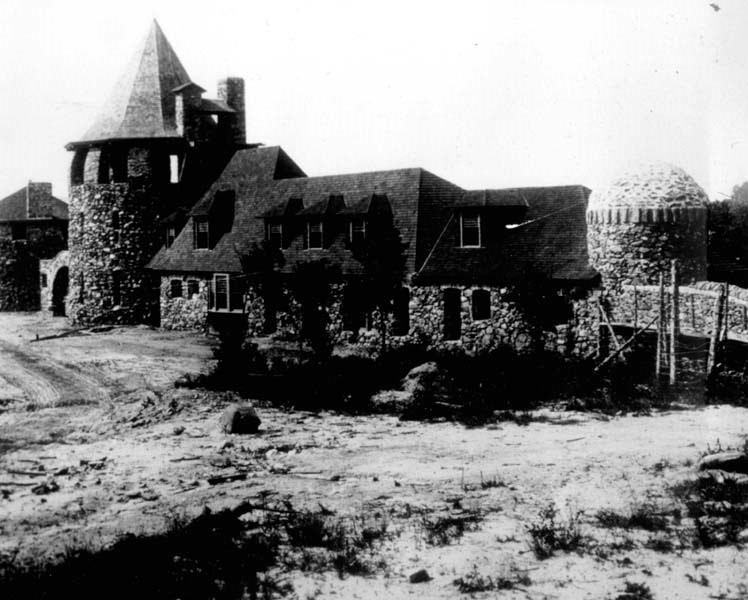
(From the collection of Richard A. Cook)

(From the collection of Richard A. Cook)
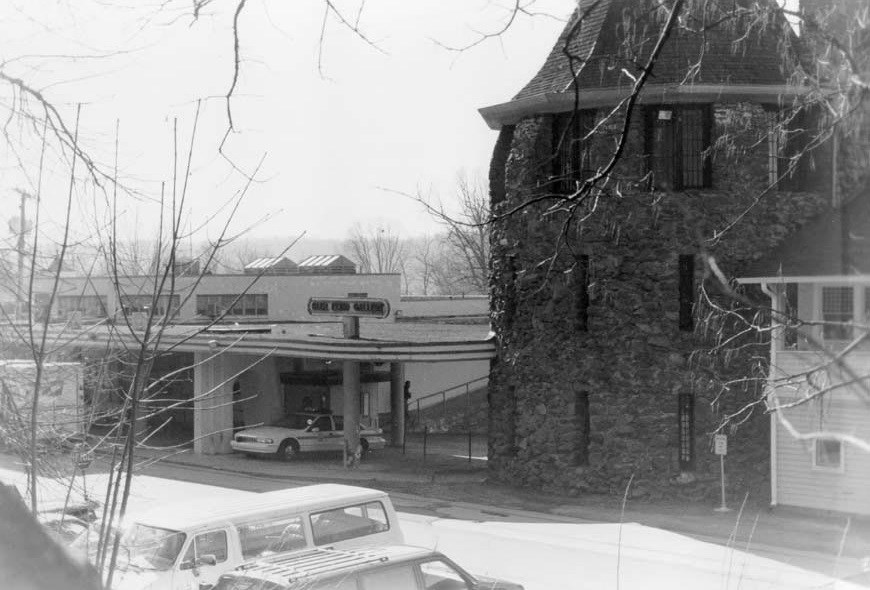
(Stephanie Gray)
Questions for Photos 1, 2 & 3
1. How has the landscape changed over time? What has been taken away? What has been added?
2. What structure appears in all three photographs? Does that structure appear to be constructed of natural or man-made building materials? How did these materials fit the purposes and atmosphere of Chautauquas?
3. Is it possible to determine from the photos how most people traveled to Glen Echo during different time periods? How do you think the changes in transportation affected the use of the Glen Echo site and the surrounding area? Do you think it is likely that more people lived in Glen Echo in 1891 or after 1911? Why?
Visual Evidence
Photo 4: Arcade Building, 1995.
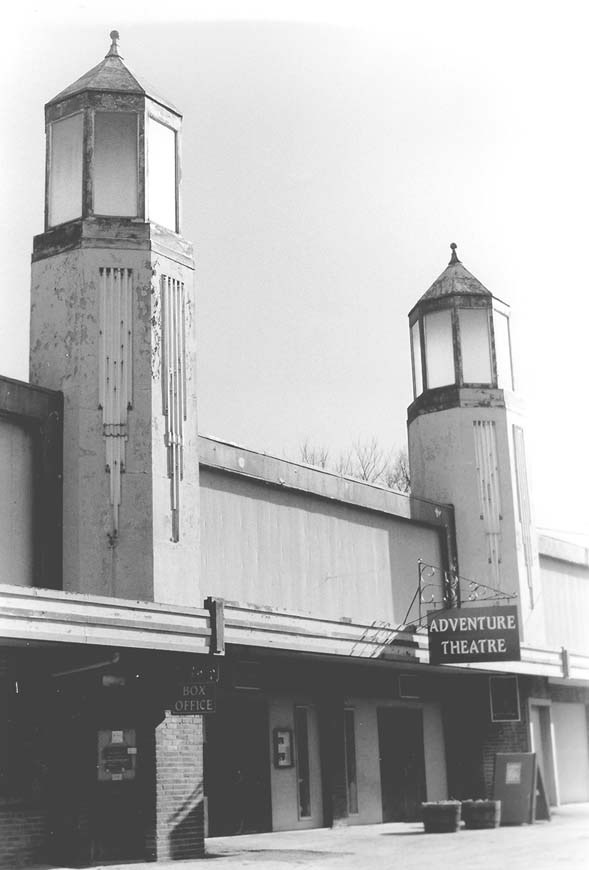
(Stephanie Gray)
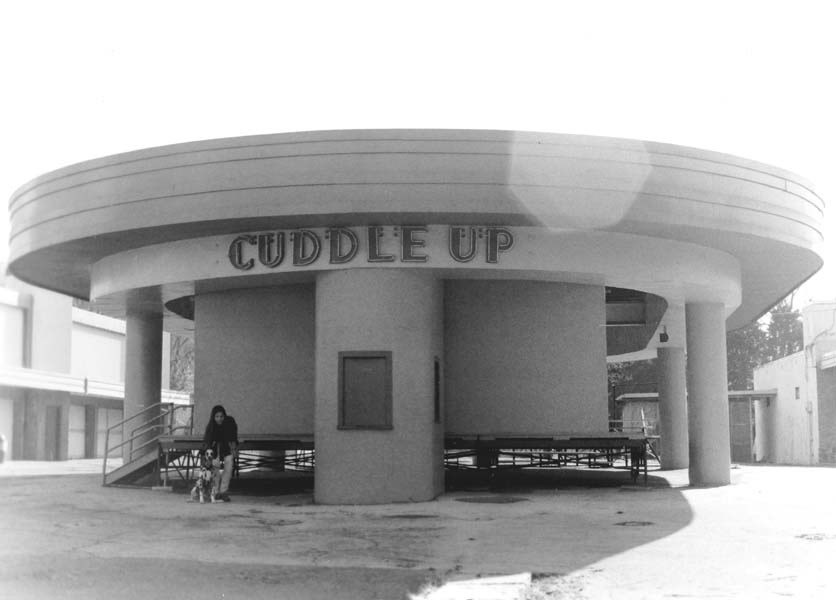
(Stephanie Gray)
Questions for Photos 4 & 5
1. Locate the two buildings on Drawing 1.
2. Do you believe Glen Echo Park was designed to look like a place for fun? What details make the build
Putting It All Together
As cities and towns grow, buildings often are torn down or heavily modified to meet new needs. Each time the Glen Echo site was developed and redeveloped it was to meet the same social need: recreation. During the late 19th and early 20th centuries, people wanted education, music, and plays with their fun. Later, for many, recreation came to be defined simply as having a good time riding the roller coaster, carousel, or dancing in the Spanish Ballroom. In recent years, fun has again been combined with learning. At Glen Echo the evolution of the site's use has come full circle; the site which started out as a center for education, socialization and recreation is again meeting those same needs a century later. Most communities will not have remnants of a Chautauqua or even an early amusement park, but they will have traditional and evolving social gathering places. Have students complete the following activities to see how their own community is similar to or different from Glen Echo.
Activity 1: Architecture in Your Own Neighborhood
People in every community have special places they go to have a good time. In the late 19th and early 20th centuries these places might have included: Chautauquas, Lycea (halls for providing public lectures, concerts, and entertainment), trolley parks, churches, fairgrounds, fraternal halls, theaters, ethnic clubs, city parks, and baseball fields. Have students determine what were popular gathering places in their communities in the past and what are now important locations for education and recreation. Have students take a walking tour of their neighborhood to see if they can find a recreation or education building or space that was created about the time of Glen Echo Chautauqua (1891-1892) or the amusement park (1899-1960s). If the neighborhood was built much more recently than Glen Echo, have them look at old newspapers or local history books to see if they can find photos of places of the same vintage as Glen Echo. What kinds of buildings or sites did they find? Did the architect seem to have made specific decisions about construction materials, design and details that related to the intended use? Why might he or she have made those decisions?
Have students pick out one building, park, or other place they especially like (old or recent) and ask them to make a sketch of the place or of design elements (style, decoration, landscaping, etc.) that they think make it special. If the place is a building, have them make notes on construction materials, the number of stories, and the kinds of doors and windows, etc. Does it have any decorative details on the front or anywhere else on the outside? Why do they think the architect chose to include those specific elements in the building? If the place is a park or other outdoor area (fairgrounds, drive-in theater, etc.), have students make notes about what buildings are there. Are they designed to look alike? Do the topography and vegetation look the same as the surrounding area or have features been added or subtracted? Do those features say something about the use of the place? Do they say something about the people who live or work in the area or about the people the place was meant to serve? What are the chances of that place surviving more than 100 years like the Chautauqua tower, or almost 100 years like some of the features of the amusement park? What economic or social factors could cause its destruction?
Sometimes people decide to modify a building to meet new needs rather than demolish it. This can sometimes lead to very interesting combinations; theaters may become churches and churches may become apartment buildings. When old buildings are preserved and new uses found for them it is called adaptive reuse. Through adaptive reuse of the historic structures, the amusement park owners and the National Park Service have been able to keep unusual buildings and use them to fit the ever-changing recreational needs of park visitors. The old Chautauqua tower has been repaired, not redone, and now serves as an art gallery. The amusement park era buildings are also being slowly and gently preserved and serve as classroom spaces. If you were to come to Glen Echo today you could ride the 1921 Dentzel carousel; learn to swing dance in the Spanish Ballroom; or learn to play the flute, paint or draw in the Candy Corner. Are there any examples of adaptive reuse in your community? What do you think about adaptive reuse of old buildings?
Activity 2: An Old Fashioned Independence Day
Have students refer to Reading 1, and note the program of the Fourth of July celebration held at the Glen Echo Chautauqua in 1892. Ask students to reenact this celebration by assuming the roles of the people who took part, and, if possible, staging the program for another class. Roles include:
-
A master of ceremonies who will introduce the performers.
-
A person in costume to recite "The Star Spangled Banner."
-
A person in costume to recite the Declaration of Independence.
-
A number of people who will present a grand musical program with performances by soloists.
Try to assign specific roles to as many class members as possible, and have other students pretend to be a typical audience of a Chautauqua. After the performance, discuss why people would have participated in such activities. Have them research to see if this kind of program was ever held in their own community. Could city parks serve the same role as the Chautauquas once did? Ask what people do now to celebrate the Fourth of July. How are current celebrations alike and different from the celebration of 1892? Ask them to discuss what other alternatives were available for entertainment in those days. Remember that in 1892 there was no recorded music, and moving pictures had yet to be invented. Which type of celebration, old-fashioned or contemporary, do they think would be the most fun?
Activity 3: Recreation and Segregation
Segregation and discrimination, both de jure and de facto, occurred (and still occurs) in many localities across the nation. Have students research the history of their community to see what groups faced prejudice in the past and those who are facing it today. Research activities include the following:
-
Talk to a long-term resident in their community and find out if there ever was segregation in their town or city. Was it enforced by law or was it based on some other factor—housing patterns, for instance?
-
Investigate what groups were discriminated against. Groups that have faced discrimination in varying degrees include, but are not limited to, African Americans, Hispanics, Asians, American Indians, Irish, southern and eastern Europeans, and the poor. Did any of these groups face discrimination of the type practiced at Glen Echo Park? Do they still?
-
Trace the history of racial and ethnic relationships in the community and in their school. What evidence do they find that discrimination is still a part of their community's culture?
After students have completed their research, have them present their findings to the class and then discuss what they could do to promote more interaction within the community. Have them draw up a list of potential activities that would make the community more pleasant for all and which would also provide fun and cultural knowledge for people of different backgrounds.
The Glen Echo Park--Supplementary Resources
Glen Echo Park: Center for Education and Recreation examines the history of one site and how it became a national park. Below are materials for further exploration of the subjects this lesson considers.
Glen Echo Park
Glen Echo Park is a unit of the National Park System. The site's web pages offers visitor information and provides information about the Glen Echo Park Partnership for Arts and Culture Inc.
History of Glen Echo
Deborah Lange's History of Glen Echo at provides a detailed look at the background of Glen Echo Park, especially its alliance with the National Chautauqua Association and its days as an amusement park.
Library of Congress: American Memory Collection
Traveling Culture: Circuit Chautauqua in the Twentieth Century
The digital collection Traveling Culture: Circuit Chautauqua in the Twentieth Century comprises publicity brochures, promotional advertisements and flyers for lecturers, teachers, preachers, statesmen and politicians, actors, singers and opera stars, glee clubs and concert companies, magicians, whistlers and other performers who traveled the circuits at the beginning of the 20th century. The brochures are drawn from the Redpath Chautauqua Collection, which is housed at the University of Iowa Libraries.
Chautauqua Association
The Chautauqua Association gives a look into the movement that started Glen Echo Park and also provides information about the many current cultural events taking place at the Chautauqua Institution.
National Amusement Park Historical Association
The National Amusement Park Historical Association provides a history of the industry, including the rise of electric traction (trolley) companies, which resulted in the amusement park boom.
Teach Civics with this Lesson
-
 First Amendment Freedoms
First Amendment FreedomsHow have people engaged their First Amendment freedoms throughout U.S. history?
-
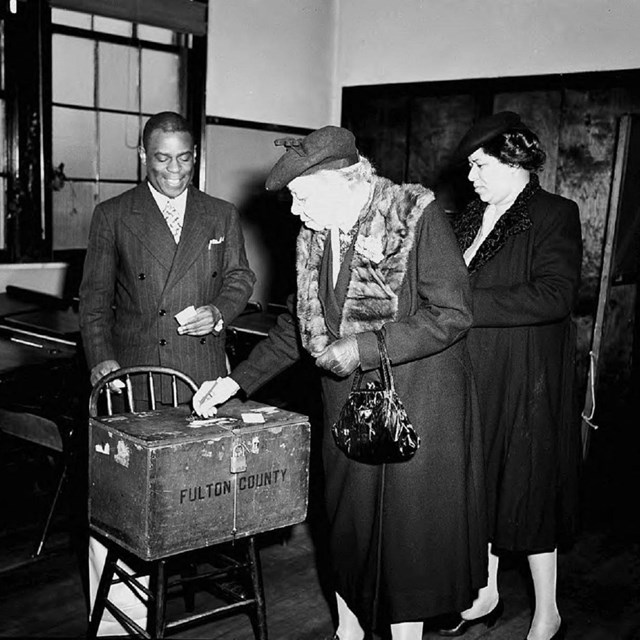 Voting Rights
Voting RightsHow is the COVID-19 pandemic affecting voting rights? What are remedies for low voter turnout?
-
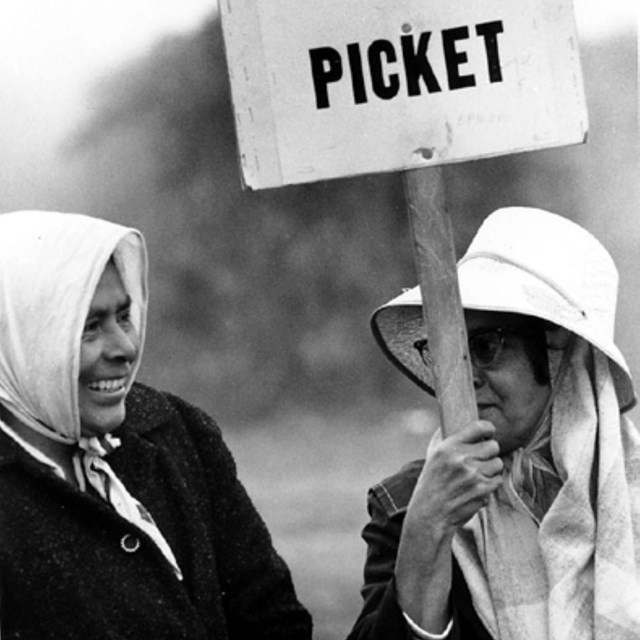 Teaching Engaged Citizenship
Teaching Engaged CitizenshipUse these mini-lessons to fit civics education into a variety of social studies classrooms.
